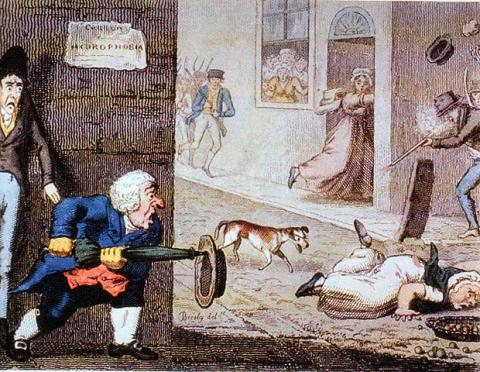-
Table of Contents
- 0. STORY PREFACE
- 1. RABIES - WHAT'S in a NAME?
- 2. RABIES in ANCIENT TIMES
- 3. WHAT IS RABIES?
- 4. LOUIS PASTEUR - EXPERIMENTER
- 5. LOUIS PASTEUR MEETS JOSEPH MEISTER
- 6. A TEEN HERO NAMED JEAN-BAPTISTE JUPILLE
- 7. LOUIS PASTEUR - WORLDWIDE BENEFACTOR
- 8. RABIES as a 21st-CENTURY PROBLEM
- 9. RABIES and ZOMBIES
In the 19th century, rabies was often referred to as “Hydrophobia,” as depicted in this 1826 illustration, by T.L. Busby, entitled “Rabid Dog in Town.” A few years later, in 1831, Pasteur was a schoolboy who observed an outbreak of rabies in Arbois, France. Image online via the National Library of Medicine.
When Celsus’ first-century treatment failed to cure (or even help) people with rabies, physicians tried other remedies throughout the centuries.
From drugs to purges, bloodletting to cauterizing with branding irons, from jumping into the sea to eating the livers of mad dogs ... not a single proposed remedy worked. The only thing people knew for sure is that someone who contracted rabies always suffered, dreadfully, then died.
Although the illness is mysterious, even today, we at least know more about how it works.
Transmitted by the bodily fluid of an infected animal, such as the saliva of a rabid dog, the rabies virus travels from the site of the bite to a person’s brain. If the virus reaches the human brain, it begins to systematically destroy it.
How does the virus move from the bite to the brain? It travels though the nerves, to the spinal cord, then straight-up into the brain.
Although rabies has a fairly long incubation period—from the time of the infected bite to the time a person develops symptoms—once the virus impacts the brain it replicates quickly and efficiently. It particularly impacts the limbic system, the part of our brain which controls our emotional and behavioral life (and helps us to form memories).

A person who has rabies will become very fearful, highly agitated and often violent. That’s because the brain is now infected, and the brain’s ability to do its job has been overtaken by the spreading infection.
From the brain, the rabies virus travels to a person’s salivary glands where it reproduces itself at astonishing rates. A person with rabies develops the inability to swallow while simultaneously developing an extreme need to drink.
Working at cross purposes—the need to drink and the inability to swallow—leads to a condition called hydrophobia (“fear of water”). Doctors who treat rabies-infected people see extremely thirsty people pushing away glasses of water. Patients become fearful of drinking because their inability to swallow causes choking.
The first symptom a rabies victim experiences is often itching at the site of the bite (even if it is completely healed). The need to itch can be so intense that victims tear their skin as they scratch and scratch and scratch (all to no avail).
As a person’s thirst increases, and their inability to swallow worsens, vocal chords become paralyzed. Accompanying paralyzed vocal chords and a distorted voice is a thickening of a victim’s saliva which gets much heavier.
After that comes the madness. The virus which causes someone’s pet to become “a mad dog,” also causes a person to become mad.
When the sick person slips into a coma, it is almost a relief. Death usually follows from respiratory paralysis.
It was to prevent such awfulness that Louis Pasteur turned his attention to developing a rabies vaccine. His main idea involved the dried spinal chord of rabbits.
-
Table of Contents
- 0. STORY PREFACE
- 1. RABIES - WHAT'S in a NAME?
- 2. RABIES in ANCIENT TIMES
- 3. WHAT IS RABIES?
- 4. LOUIS PASTEUR - EXPERIMENTER
- 5. LOUIS PASTEUR MEETS JOSEPH MEISTER
- 6. A TEEN HERO NAMED JEAN-BAPTISTE JUPILLE
- 7. LOUIS PASTEUR - WORLDWIDE BENEFACTOR
- 8. RABIES as a 21st-CENTURY PROBLEM
- 9. RABIES and ZOMBIES
Media Credits
Image of the Limbic System by Bruce Blace and Blausen.com staff. Online via “Blausen gallery 2014.” Wikiversity Journal of Medicine. DOI:10.15347/wjm/2014.010. ISSN 20018762
Video embed, via YouTube, from the "Rabies in Asia Foundation." In India, for example, around 20,000 people die each year following bites from rabid animals.


 Back
Back
 Next Chapter
Next Chapter

 Back
Back
 Next Chapter
Next Chapter
